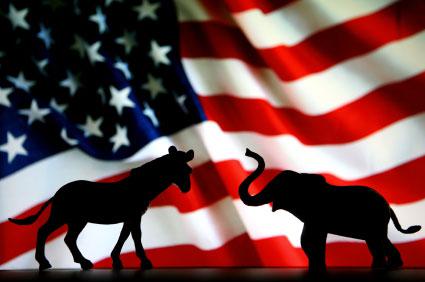
Photo courtesy of iStockphoto.
The median voter theory suggests that in a two-party system with an electorate composed of a left-right spectrum a Presidential nominee need only win over the voter in the middle of the political continuum in order to clinch an election. The idea is that if a candidate claims the middle they claim everyone to the left or right of them, depending on what side they lean to. This presents interesting strategies and patterns that can be spotted if you follow Presidential contests closely. Paint your opponent as extreme and out of the mainstream, or cast your opponent as a straw man by arguing against a more severe caricature of him. And alternatively you must present yourself as the archetype American, the common person who a typical citizen can identify with. The middle decides elections between two candidates and they pick the nominee who they believe stands closest to them in the political spectrum.
In an election year where there are no incumbents both candidates must run to their respective left and right corners during the primary season. Once they have locked up the vote from the party loyalists and secured a nomination they can begin to moderate and tack back to the center. However, if there is an incumbent in the race, who does not have a primary challenger, the person seeking reelection has the benefit of staying closer to the center during the entire campaign season, a fairly significant advantage.
When moving to the middle immediately after nomination it is too easy to be accused of lacking principles, being a flip-flopper, or otherwise appearing contradictory, and thus untrustworthy. The party loyal can become alienated in a sudden move to the middle, causing a political base to lose enthusiasm and spur a low turnout on election day. Plus the recency of many partisan speeches intended to appeal to a narrower political base can leave a residue that makes severe caricatures easier to digest. It is much harder to appear centrist when you have just been trying to convince your party that you are not moderate.
The Republican party has been pulling quite heavily to the right these days, which is evidenced by the ambivalence for Former Governor Mitt Romney. Former Speaker of the House Newt Gingrich constantly refers to Romney as a Massachusetts moderate, while categorizing himself as a true conservative in the race. Of course Romney has been trying to beef up his conservative credentials by marketing himself as an unabashed free market capitalist. All of the running to the right may be taking a toll on both candidates.
A recent Washington Post-ABC News poll shows that only 23% of independent voters view Romney as favorable, with 51% having a specifically unfavorable view of him, a telling change since the beginning of January when Romney faired 18% better. Independents appreciate Gingrich even less, with 22% favorable and 53% unfavorable. Among moderates Romney is favored by 27%, and unfavored by 52%, while Gingrich is at 20% favorable and 58% unfavorable with the middle. Considering that Obama has a 51% favorability among independents and a 66% favorability among moderates, the GOP nominee is going to have to run hard to the center once their party has chosen who they will be. It will be interesting to see how this works out for them.
Jared Roy Endicott


